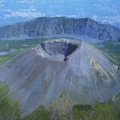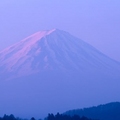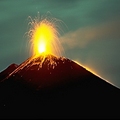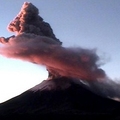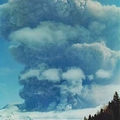Eco-friendly locations / The Best Volcanoes to Visit in the World / Popocatepetl
Popocatepetl
The Mexican territory is like a giant bowl of Mexican plateau. The volcanic plateau Mesa ( which in Spanish means - "table") lies in the center of it, bordered on two sides by steep rocky ridges of the Western and of the Eastern Sierra Madre. Along the southern margin of the plateau the Transverse Volcanic Sierra stretches from the east to the west - a gigantic mountain barrier formed by fused into a majestic wall of cones of volcanoes. This is one of the largest volcanic systems of the Earth, which can be compared with that unless the East Ridge of Kamchatka with its dozens of active volcanoes and the famous Avenue of the Volcanoes in Ecuador. Here is the highest mountain in Mexico and the second highest mountain in the North America - the Orizaba volcano. Its right cone rises above the plateau for three miles, and the total height of Orizaba above the sea level exceeds the height of Mount Elbrus. However, the eruptions of Orizaba were already three hundred years, so that Mexicans do not perceive it as a volcano.
Description
Another volcano, located in the west is Popocatepetl, familiar to every inhabitant of the capital of Mexico City, as the white silhouette of Fuji is familiar to the Japanese in Tokyo. The very name of it (in translation from the language of the Aztecs - the ancient inhabitants of Mexico is the "smoking mountain") which describes its turbulent disposition. And besides, "the Mexican Fuji" has a dozen active smoking volcanoes, which growl and spit stones in the fire-breathing mountain range, not counting those that are temporarily or permanently "asleep", like an elegant neighbor of Popocatepetl, the Istaksiuatl mountain. These two mountains located near the Aztecs worshiped their gods apart offering rain. Each year, they made sacrifices, asking that the clouds, gathered at their tops, turned into clouds of rain and showering the field of celestial grace moisture.
The Legend
The Aztec legend says that in ancient times, a young man Popocatepetl, in love with a beautiful Istaksiuatl, did not want to throw it when the gods drew up the hill for the hapless grave misconduct. He prayed to the gods, and they granted his request. Since then, he stands next to his beloved over the valley of Mexico. The Aztecs volcano could be both a mountain god and man, and many of the formidable mountains revered by locals and were objects of worship. But the only unanimous Popocatepetl caused awe and love for all Indians. And these days, long ago mingled with the Spaniards and retained a love relationship to "El Popo", as it is called by the people. Of course, not all fire-breathing mountains of the Transverse Volcanic Sierra soar more than five miles and sparkle with snow, as Orizaba and "El Popo". Among them, very small black cones of young volcanic structures are raised, many of which deliver a fair concern of the inhabitants of the nearby villages. Volcanoes occur here in the present. Thus, the volcano Horulo appeared in the XVII century. The repeated monster, now has grown to one thousand three hundred meters and is not going to be complacent. Another volcano, Parikutin was born in 1943. The eruption began unexpectedly. The peasants who sowed corn, noticed a crack in the middle of the field, which released from the suffocating gas. Soon the lava flew from the slot, formed a cone, which continued to grow, reaching a height of three hundred meters. The flow of the molten basalt rushed towards the Parangarikutiro village for six miles and destroyed it. Several thousand hectares of fields and woods in the vicinity were burned and buried the ashes.
The volcano activity
The volcano has erupted almost continuously for nine years forming a cone of two thousand eight hundred meters. Popocatepetl does not make such troubles as Parikutin to the local residents. The last big eruption was in the 820 year. Since then, there are twelve centuries that it only occasionally throws a cloud of volcanic gases, ash and incandescent fragments of lava. And then the inhabitants of Mexico City, located half a hundred kilometers from the volcano, said: "El Popo is angry." This burst of activity was at Popocatepetl in 1923 and then repeated over seventy years. The danger in this case were not the fiery lava rivers, mudslides and powerful, formed from the melting glaciers on the slopes of the revived volcano. But the melted glacier water, mixed with ashes and rubble of lava sheets, mad rushes provoked an avalanche running down through the gorges, sweeping away everything in its path. Fortunately, the eruption of 1993 has not affected the northern slopes of the "El Popo", so that the residents of the suburbs of the Mexican capital were not injured. Volcanoes are known to bring people not only grief and misery. Everywhere in the vicinity of volcanoes, whether on the island of Java or the Philippines, Japan, or in Sicily, they form fertile volcanic soils favorable for the farmers to harvest rich crops. In such places, Wild vegetation violently stretches to the sky in such places which leads sometimes to the appearance of these giants of the "green world". Mexico, in this sense is no exception. Here, on the southern slope of the Transverse Volcanic Sierra, near the town of Tula, one of the largest and the oldest trees on our planet are growing. The mighty yew, called "The Tree of Thule," is declared a nature sanctuary in Mexico. Its age, according to some scientists, is more than four thousand years. Others, more skeptical-minded, believe that it has "only" two thousand years. But even if the "Tree of Thule" was a contemporary of the Egyptian pharaohs, its dimensions equals respect. The height of the gigantic yew exceeds forty feet, the height is equal to a thirty floor building and the circle is equal to thirty-eight meters. This means that the tree can be embraced by thirty adult men. The shadow of the green giant crown covers an area of eight hundred square meters and the weight of the huge hole is about five hundred and fifty tons! If cut down, then to transport it would take fifty timber railway platforms. According to the legend, under the "Tree of Thule" five centuries ago the Spanish conqueror of Mexico, Cortez was camping. Later, the Spaniards built beneath a Catholic church, which seems a toy next to the giant tree. Cortes, incidentally, marked the beginning of the economic use of the Mexican volcanoes. It was he who sent a detachment of his men at the top of Popocatepetl, so they got out of the crater more sulfur for the manufacture of gunpowder. Volcanic sulfur deposits in the vicinity of the Mexican volcanoes developed so far. Reserves of this fossil Mexico are ranked first in the world. Volcanic eruptions occur in the country almost every year. The seismic activity takes place in the area. It is believed that a tenth of all earthquakes on the planet occur in Mexico, and its banks. Nevertheless, Mexicans love their volcanoes. Whether in jest, if they continue to argue seriously that the snow-capped giants maintain their divine power as before and it depends on whether the clouds gather in the swollen rain clouds or dispel them without a trace. Just as the Japanese worship Fujiyama, the Nepalese - Mount Everest, and the negroes Maasai, Tanzania - Mount Kilimanjaro, the twenty millionth residents of Mexico City affectionately revered "El Popo", in any weather and well marked from the windows of skyscrapers, and houses of the poor outlying huts of the giant metropolis. Popokatepetl is located at just 40 kilometers from the capital, Mexico City, and it is considered a symbol of the country. All night the giant roars, and then begins to throw stones from the crater and lava for several kilometers. In the last 20 years it became more active, and since that time it is closed to tourists.
Maps of Popocatepetl
map MexicoOthers from The Best Volcanoes to Visit in the World
A volcano is formed by a non-visible internal structure of the crust including magma chamber , magma pipes and a visible structure.
More commonly, the term volcano refers only to the outside and the visible part to the right of the volcanic relief , more or less conical, consisting of all those materials, liquid, solid or gaseous fuels, which were issued from the craters during the various stages of the eruption of the volcano itself.
The masses of rocks which form a volcano are called igneous rocks , as derived from the cooling of the magma ascended from the Earth .
The shape and the height of a volcano depend on several factors including the age of the volcano, the type of the eruptive activity, the type of the released magma and the characteristics of the underlying volcanic structure.
In general volcanoes are discontinuities in the Earth's crust through which all various events and magmatic endogenous products: powders, gases, vapors and solid volcanic material is casted.
The release of this material is erupting and the erupted materials are lava , ash , gas , slag and various water vapors .
On the surface, 90% are submarine volcanoes (mostly located along the dorsal mid-ocean), while about 1500 volcanoes are now active on land.
Description What is commonly called a volcano, technical terminology is defined in the volcano or volcanic cone , but since the term most used is the volcano.
The volcano is often named in geology .
The volcanoes testify to the existence, in the deep zones of the lithosphere , the molten masses of silicate are called natural magmas .
A generic volcano is formed by: a magma chamber or a magma basin, fed by magma , when it is empty after an eruption.
A volcano may collapse and create a caldera .
The magma chambers are located between 10 and 50 km depth in the lithosphere .
a stack or a duct volcanic main crossing point of the magma from the magma chamber to the surface.
a crater summit, where the main pipe flows.
one or more secondary ducts, which, flowing from the flanks of the volcano or the same basis, give life to the secondary cones.
lateral cracks, fractures on the longitudinal side of the volcano, caused by the pressure of the magma.
They allow the escape of lava in the form of eruption.
For their grandeur of the event the volcanoes are an object of admiration, of fear, of curiosity and of study since the antiquity with different interpretations created to explain its origin.
Plato admitted the existence of an underground river of fire.
Seneca indicated as the cause of eruptions and earthquakes, the penetration of water into the ground, when the water reached the incandescent matter, vapors under high pressure.
In 79 AD ,Pliny the Younger described the eruption of Vesuvius that buried Pompeii , Herculaneum and Stabiae.
But the real science that studies volcanoes, the volcanology ,was born only in the seventeenth century , when the naturalists were interested in the eruptions of Vesuvius ( in 1631 ) and of Etna ( in 1669 ).
This science is more decisive in progress with the studies of Spallanzani and then in the nineteenth century , with the help of petrography .
The origin of volcanoes is explained by various theories, including two important, but opposite theories: the theory of craters of lifting De Buch ; the theory of external accumulation of Scrope and Spallanzani .
In the theory of De Buch, volcanoes would have originated from the magma which would raise the outer layers of the Earth forming the cone, which then would break up to form the craters.
In the second theory, the volcanoes would be due to the accumulation of the solid material emitted or projected from the volcanic conduit.
The heat that is produced inside exerts a pressure evenly over the crust, thinner where the magma would surrender, letting it , causing the birth of the volcanoes.
The classification of volcanoes The volcanoes can be classified according to the type of external device or the type of the volcanic eruptions, both of these characteristics being closely linked to the composition of the magma and the magma chamber (and thus emitting lava).
This classification is called Lacroix Classification by the French geologist Alfred Lacroix who first conceived.
Depending on the type of the volcanic external apparatus Considering the type of the volcanic cone there are 2 types of volcanoes: 1.
Shield volcanoes 2.
Cone volcanoes Shield volcanoes A shield volcano has moderately sloping sides, and it is built by the eruption of the lava basalt fluid.
The basaltic lava tends to build enormous cones low slope, because its low viscosity allows it to slide smoothly on the ground or under it, in the lava tubes, up to many kilometers without significant cooling.
The major volcanoes of the world are the shield volcanoes.
The name comes from the same geometry, which makes them look like shields resting on the ground.
The largest shield volcano in the world is in Hawaii , its name is Mauna Loa .
It measures about 4000 m above the sea level , but its base is located at 5000 feet below the sea level, so its actual height is of 9000 meters, while its base diameter is about 250 km.
Cone volcanoes We find a volcano cone when the lava is acidic.
In these cases, the magma is very viscous and it is difficult to trace, solidifying quickly once outside.
Emissions flow and alternate with the solid material that is shot out and alternate with the cast, as the layers of the building.
The eruptions of this type can be very violent (like that of Vesuvius that buried Pompeii ), because the magma tends to obstruct the volcanic chimney creating a "cap" only when the internal pressures are sufficient to overcome the obstruction, the eruption resumed ( the eruption of Vulcan type), but in extreme cases there may be an explosion that may come to destroy the entire volcano ( Peleus).
The volcanism of this type is present along the continental margin of the pits or arc-trench systems, where the magma comes from the crust where the rocks are more of an exogenous composition.
Depending on the type of the eruptive activity Broadly speaking we distinguish red volcanoes (volcanoes characterized by effusive emissions in which the accumulation of the volcanic lava flows gives the building looks "reddish brown"), and gray volcanic (eruptions of volcanoes with explosive character in which the accumulation of ash give the building looks gray-black volcanic).
Specifically, considering the type and the power of the eruption of a volcano you have: 1.
Hawaiian volcanoes in eruption type 2.
Volcanoes in eruption of Icelandic type 3.
Strombolian volcanoes in eruption type 4.
Volcano eruption at Vulcan type 5.
Volcano eruption at Vesuvius type 6.
Plinian eruptions at volcanoes and Pelean type 7.
Large calderas ("super-volcanoes") Hawaiian Type The eruptions are not related to the tectonic movements that are due to the plaque but rather to see the phenomena the magma plumes from the back to warm up the hot spots.
The summit of the volcano is occupied by a large depression called caldera , bounded by steep walls due to the collapse of the fund.
Others occur within the caldera collapses, creating a well structure .
The lava is very basic and therefore very fluid, it produces the typical volcanic edifices form a "shield , with weak slopes of the mountains.
Icelandic type They are also called volcanic fissure eruptions which occur through long slits and not by a circular crater.
The casting, basic and the ultra basic magmas fed by, tend to form the highland basalt (basalt plateaus).
At the end of an eruption fissure (or linear), the eruptive fissure may disappear since it is covered by lava and solidified spill, does not reappear until the next eruption.
The best examples are found in Iceland , from which the special designation of the type, an excellent example of the Icelandic volcano eruption is that of Laki of 1783 , one of the most famous volcanic eruptions in the history of the European Union .
Strombolian type Very viscous basaltic magmas give rise to an enduring characterized by emissions at regular intervals and fragments of lava fountains that reach hundreds of meters high, and the launch of lava and volcanic bombs.
The fallout of these products creates scoria cones from the quite steepides .
Stromboli , the island-volcano from which it takes its name, this kind of effusive activity, has been in business for two millennia, much to be known, since the time of the earliest civilizations as the " lighthouse of the Mediterranean .
" Type Vulcan They were named after the island of Vulcano in the archipelago of the Aeolian Islands .
They are explosive eruptions during which lava bombs release clouds of gas and ash laden.
The explosions can produce fractures, ruptures of the crater and the opening of lateral vents.
Vesuvius type From the name of the volcano Vesuvius , it is similar to the Vulcan, but with the difference that the initial explosion is tremendously violent enough to drain most of the magma chamber: the magma from deep zones, then back up at high speed out of the crater and dissolve in tiny droplets.
When this type of eruption is at its most violent it is called Plinian eruption (in honor of Pliny the Younger who first described the course in 79 AD).
Plinian type The eruptions are produced by very viscous magma .
Hot clouds are frequently formed from gas and pulverized lava.
They are very dangerous eruptions ending usually with partial or total collapse of the volcano or the release of a plug of lava that of a volcanic plug or dome .
In some cases both phenomena occur.
The volcanic eruption that exhibits this behavior are characterized by the shape of a cone.
These eruptions are named for Pliny the Younger who first described this type of eruption observing the eruption of Vesuvius in 79 AD, which submerged Pompeii and Herculaneum in ashes .
A variant is the Plinian eruption : if during a Plinian eruption the main body of the glowing cloud released from the crater summit during an eruption peleana (which takes its name from the volcano 's Pelee in Martinique ) , the volcano erupts from the crater, but not centrally splitting up the side of the volcano.
This eruption has devastating effects concentrated in the direction of the main eruption of a glowing cloud that can reach more than 20 km from the building volcanic (as happened in 1980 in the eruption of St.
Helens ).
Other variants of the Plinian eruptions are the ultra-plinian : these eruptions are characterized for having an even bigger explosion, which may come to completely destroy the volcanic edifice (it is an example of the Krakatoa or Santorini ), and above all for the enormous amount of the released volcanic ash.
The explosion of this type, based on the large amount of ash that remains in suspension in the atmosphere, has a greater or lesser impact on the global climate in the years following the eruption.
Large calderas Although not recognized as true volcanoes, they deserve a separate mentioning: the case of 7-8 large calderas identified on the surface.
These structures are characterized by not having a volcano rather than a depression of volcanic origin (known as Caldera), which covers a vast area, more than 10-15 km.
Inside the caldera, you can see the development of various craters formed more or less.
It was never observed an eruption of this type of calderas (which have periods of eruption of hundreds of thousands of years) and these areas are now subject only to a minor type of volcanism (geysers, fumaroles, hot springs, .
.
.
).
The best known examples of this type of equipment is the park of Yellowstone , The Phlegraean Fields , the Alban Hills , the Toba Lake .
Activities of volcanoes The magma rises through the mantle or less dense than the Earth's crust because of the surrounding rocks (lifts for buoyancy ).
During the ascent, due to the decrease in pressure , the gases dissolved in the melt dissolve a further decrease of the density .
The magma in the crust can build up, to cool and solidify, or climb up to the surface of the earth thus giving rise to an eruption .
The eruptions may be of different types: they can give rise to explosive phenomena, where ash and lapilli are projected up to tens of kilometers above the crater and deposited up to hundreds of miles away from the eruptive center, or effusive, if the magma flows, forming a lava flow that propagates to shorter distances (tens of meters to a few km from the eruptive center).
One of the characteristics that influences the type of the eruption is the viscosity of the magma, which depends on the content of silicon , which binds with the oxygen molecules that form always tend to bond with each other and form indestructible chains.
If the magma has more than 60% silica [SiO2] it is considered viscous and more likely to give rise to an explosive eruption, but if the magma has less than 50% silica it is likely to be erupted with dynamic and effusive emitted lava as flows.
Here is a presentation of the most famous and the most popular volcanoes in the world.
Of course, I referred to their power of eruption, their activity and their beautiful environment provided to visitors.
Volcanoes represent huge interest to people, not only for the fact that they are dangerous but for many other reasons too.
Discover the most famous volcanoes in the world.

